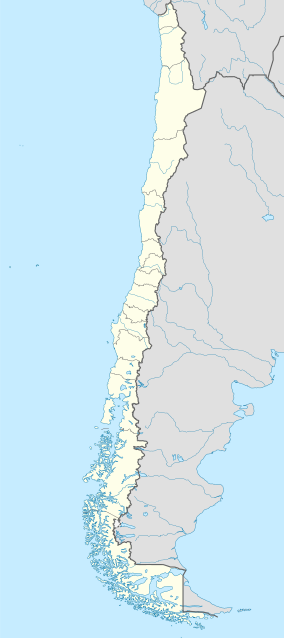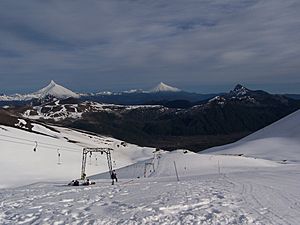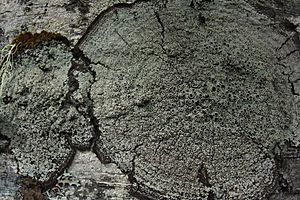Puyehue National Park facts for kids
Quick facts for kids Puyehue National Park |
|
|---|---|
|
IUCN Category II (National Park)
|
|

Constancia Lake within the national park.
|
|
| Location | Los Lagos Region, Chile |
| Nearest city | Osorno |
| Area | 1,070 km2 (413 sq mi) |
| Established | 1941 |
| Visitors | 133,037 (in 2012) |
| Governing body | Corporación Nacional Forestal |
Puyehue National Park is a huge natural park located in the Andes mountains of Chile. It stretches across the Los Ríos and Los Lagos areas. This amazing park covers about 220,000 acres! It's famous for its natural hot springs, volcanoes, and beautiful evergreen forests.
Puyehue National Park is one of Chile's most popular parks. Around 400,000 people visit it every year. It's also part of a special area called the Reserve of Temperate Rainy Forest Biospheres of the Southern Andes. A road called Chile Route 215 goes right through the park. This road connects Chile with Argentina through the Cardenal Antonio Samoré Pass.
Contents
Exploring Puyehue National Park
The park is dominated by some impressive natural features. These include the Puyehue volcano, Cordón Caulle, and the Antillanca Group. The park is split into three main visitor areas. These are Aguas Calientes, Anticura, and Antillanca. Each area offers different and exciting activities for you to enjoy!
Aguas Calientes: Hot Springs Fun
The Aguas Calientes area is known for its natural thermal baths. These are warm pools where you can relax. You can also find many fun hiking trails here.
Anticura: Volcanoes and Waterfalls
In the Anticura area, you can see the Puyehue volcano up close. There's also a great spot called El Puma lookout point. You can explore a volcanic area and even a strawberry field called Pampa de Frutilla. Don't miss the Salto de la Princesa, which is a beautiful waterfall. This area also has an 800-year-old forest of coigüe trees.
Antillanca: Skiing and Lakes
The Antillanca area is home to the Raihuén crater and Mirador hill. You can also see the Las Gaviotas river and part of Rupanco Lake. If you love winter sports, you can go skiing at the Antillanca ski center. It's located on the slopes of the Casablanca volcano.
Rivers and Lakes in the Park
The park has several important rivers and lakes. The Golgol and the Las Gaviotas river are the main waterways. The Chanleufú also flows through the park. Some parts of the Golgol river flow into Lake Puyehue, which is just outside the park. Inside the park, you'll find five beautiful lakes. These include Constancia, Gris, Paraíso, Lake Berlin, and part of Rupanco Lake.
Park Management and Facilities
Puyehue National Park has special warden stations in each of its three areas. The main office is in the Aguas Calientes area. There's also a Center of Environmental Information. Here, you can learn all about the animals and plants in the park. This center is in both the Aguas Calientes and Anticura areas.
The Anticura area has a CONAF guard station and a campsite. In the Antillanca area, you'll find a ski center and a hotel that's open all year. Entering most of the park is free. However, the Anticura section costs about 800 Chilean pesos, which is a small fee.
Where to Stay and Relax
The park offers different places to stay. There's a hotel with a thermal complex, which means it has hot spring pools. You can also find a lodging house, cabins, and campsites.
Fun Activities in the Park
Puyehue National Park is a fantastic place for outdoor adventures! You can go hiking and trekking on many trails. It's also great for fishing and observing the amazing plants and animals. You can swim in heated pools, take photos, or go climbing. Other activities include excursions, horseback riding, and mountain biking. In winter, you can enjoy snowboarding, downhill skiing, and cross-country skiing. It's also a wonderful spot for bird watching.
Trees and Plants of Puyehue
The lower parts of the park are covered by a type of forest called the Valdivian temperate rain forest. This forest is very rich with many different kinds of plants. You'll find tall evergreen trees like coigüe (Nothofagus dombeyi), ulmo (Eucryphia cordifolia), olivillo (Aextoxicon punctatum), and tineo (Weinmannia trichosperma). The ground beneath the trees is full of bushes, ferns, moss, and lichens.
As you go higher up, the trees change. You'll see more coigüe woods mixed with tepa (Laureliopsis philippiana) and mañío (Saxegothaea conspicua). Closer to the tree line, you'll find forests of Nothofagus betuloides and Nothofagus pumilio. These trees have leaves that turn reddish in the autumn. You might also spot marshy areas called "mallines" covered in thick moss. Other trees include Nothofagus antarctica and the cypress of Guaitecas (Pilgerodendron uviferum).
Animals of Puyehue
The park is home to many interesting mammals. You might see a puma, a gray fox (pseudalopex griseus), or a ferret (galictis cuja). There are also coypus (Myocastor coypus), wild cats called güiña (Felis guigna), and skunks (Conepatus chinga).
Puyehue National Park is also a fantastic place for bird watching. Keep an eye out for the torrent duck (pato correntino) and the large Magellanic woodpecker (carpintero negro). You might also spot the Chilean pigeon (torcaza), the hued-hued (huet-huet), and the majestic Andean condor. Other birds include the great grebe (huala), the house wren (chercán), and the buff-necked ibis (bandurria).
Hiking Trails to Explore
The park has many trails for different levels of hikers.
Trails in Aguas Calientes Area
- Berlín Lake Excursion Trail: This trail is about 6.8 miles long and takes around 5 hours to complete (round trip). It leads to Berlín lake, where there's a small shelter.
- El Pionero Recreational Trail: A shorter trail, about 5,905 feet long, taking 1 hour and 20 minutes round trip. It leads to a nice viewpoint.
- El Recodo Recreational Trail: Very short at 1,246 feet, taking only 15 minutes round trip. It connects to the Aguas Calientes area where you can find food.
- Chanlefú Rapids Educational Trail: This 3,937-foot trail takes about an hour and a half round trip. It leads to beautiful waterfalls and river rapids.
- Los Derrumbes Recreational Trail: This trail is 1,902 feet long and takes about 45 minutes round trip.
- Hot Springs Pools: The pools in Aguas Calientes can reach up to 42°C (107°F). They are a perfect spot to relax by the Rio Pichilanleufu.
Trails in Anticura Area
- Puyehue Volcano Excursion Trail: This challenging trail is 9.9 miles long and takes 2 or 3 days round trip. It's a self-guided path that goes up to the volcano, sulfur deposits, and hot springs. There's a shelter for 12 people on the volcano's slopes.
- Strawberry Field (Pampa de la Frutilla) Excursion Trail: This 12.4-mile trail also takes 2 or 3 days round trip. It crosses a forest and leads to an Andean prairie. There's a rustic shelter at Laguna Seca.
- Salto de la Princesa Recreational Trail: A short, 2,329-foot trail that takes about 30 minutes. It leads to the Salto de la Princesa waterfall.
- Salto del Indio Recreational Trail: This 3,116-foot trail takes about 40 minutes round trip. It's a self-guided path that shows you the evergreen forest and 800-year-old coigüe trees. It also leads to a waterfall on the Gol-Gol river.
- Repucura Educational Trail: This trail is 3,608 feet round trip.
- El Puma Lookout Point Trail: This 4,593-foot trail takes about an hour and a half round trip. It crosses the Anticura River on a hanging bridge and goes up to a viewpoint. From there, you can see the Puyehue volcano and the Gol-Gol river valley.
Trails in Antillanca Area
- Mirador Hill Trail: This trail is 2.4 miles long. In summer, a road from the hotel goes up to the Raihuén crater and Mirador hill. This is also where an excursion trail starts, leading down to the Las Gaviotas river and the bank of Rupanco lake. At the lake, you can enjoy water sports, fly fishing, and explore the rainforest. You might even see deer on the islands! The Puntiagudo and Osorno Volcanoes can be seen from here.
- Skiing at Antillanca: You can also go skiing at the Antillanca ski center. It's located on the slopes of the Casablanca volcano.
Weather in the Park
It rains quite a bit in Puyehue National Park throughout the year. The rainiest months are usually between March and September. During winter and spring, you'll find snow on the ground. The average temperature for the year is about 8°C (46°F). In the summer months, temperatures rise to between 10° and 18°C (50° and 64°F).
Energy Project in the Park
In 2008, a project to build a hydroelectric power plant was approved for the park. This caused some discussion because it was a private company building in a public park. People also worried about how it might affect the environment.
See also
 In Spanish: Parque nacional Puyehue para niños
In Spanish: Parque nacional Puyehue para niños





